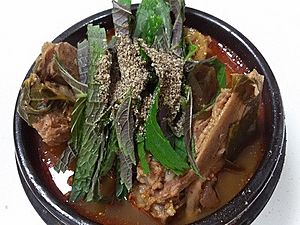Gamja-tang facts for kids
 |
|
| Alternative names | Pork back-bone stew |
|---|---|
| Type | Tang |
| Place of origin | Korea |
| Main ingredients | Pork backbone |
| Ingredients generally used | Potatoes, deulkkae, scallions, garlic |
| Korean name | |
| Hangul |
감자탕
|
|---|---|
| Hanja |
甘藷湯
|
| Revised Romanization | gamja-tang |
| McCune–Reischauer | kamja-t'ang |
| IPA | [kam.dʑa.tʰaŋ] |
Gamja-tang (감자탕), also known as pork back-bone stew, is a super tasty and spicy Korean soup. It's made with the bones from a pig's spine or neck. This hearty stew often includes yummy potatoes, clear cellophane noodles, dried radish greens, and perilla leaves. You'll also find green onions, garlic, hot peppers, and ground sesame seeds in it.
The pig bones are usually separated, with bits of tender meat still attached. They are boiled for a long time at high temperatures to make the meat really soft. To get the meat off the bones, you can use chopsticks. This meal is usually served with kimchi and a bowl of rice. People enjoy Gamja-tang for lunch or dinner, and it's also a popular late-night snack!
The soup itself has a deep red color. This comes from the red hot peppers used to make it spicy and flavorful.
Gamja-tang is now a common dish in Korean restaurants all over the world. You can find it in places like the United States and Canada, not just in Korea.
History of Gamja-tang
Gamja-tang first came from the southern Korean province of Jeolla. Long ago, farming was the main way people made a living in Jeolla Province. Farmers there raised many hogs (pigs) for food. The story of Gamja-tang goes back to the Three Kingdoms era. During this time, farmers in South Jeolla raised more hogs than in most other parts of Korea.
Back then, cattle were very important for farming. They helped with plowing fields and provided manure for crops. Because of this, cattle were much more valuable than hogs. It was more common to use hogs for special meals and celebrations than to use beef. This helps explain why Gamja-tang is made with pork.
When Incheon harbor opened, many people moved to Seoul and the areas around it. These people came from Jeolla Province and other parts of the country. In 1899, construction began on the Gyung-ui Railway. Many workers started building the railway near Incheon. Gamja-tang became very popular among these workers. It was cheap, healthy, and had a lot of fat, which gave them the energy they needed for their hard work. Over time, Gamja-tang became one of the most famous foods of Incheon.
See also
 In Spanish: Gamjatang para niños
In Spanish: Gamjatang para niños

